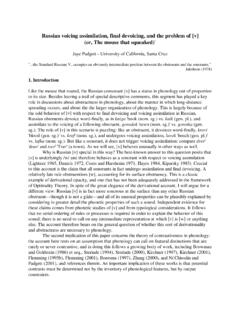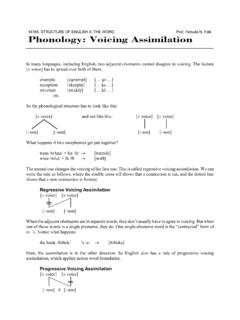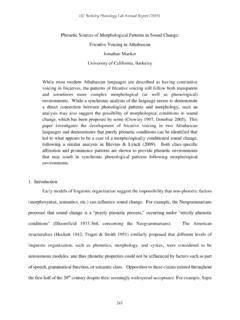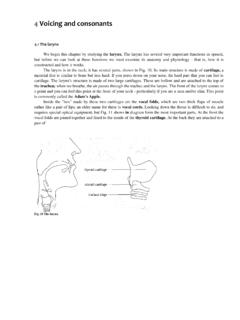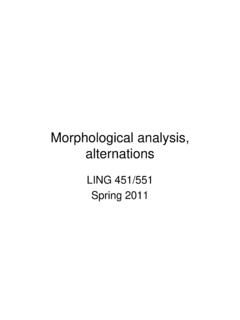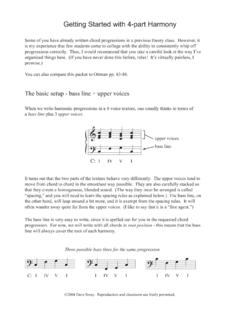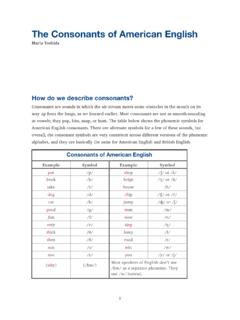Transcription of Chapter 4 Perception of Intervocalic Voicing and ...
1 Chapter 4 Perception of Intervocalic Voicingand SpirantizationThis Chapter reports the results of three experiments that were designed toexplore the possible role of Perception in the lenition of Intervocalic stops. Asdiscussed in the introduction, the potential effect of perceptual factors on lenitionhas received little attention in the literature, Kingston (2008) being a recent ex-ception. The particular perceptual model that I examine is the P-map (Steriade2001a,b).Recall the basic typological fact I intend to account for that spirantizationof Intervocalic voiceless and voiced stops (as in (1)) and Voicing of intervocalicvoiceless stops (as in (2a)) are attested, while devoicing of Intervocalic voicedstops (as in (2b)) is not.
2 (1) : Intervocalic voiceless stops targeted for spirantization ( , Tiberian Hebrew)(i)/VpV/ [VFV]69(ii)/VtV/ [VTV](iii)/VkV/ [VxV] : Intervocalic voiced stops targeted for spirantization ( , Spanish)(i)/VbV/ [VBV](ii)/VdV/ [VDV](iii)/VgV/ [VGV](2) : Intervocalic voiceless stops targeted for Voicing ( , Warndarang)(i)/VpV/ [VbV](ii)/VtV/ [VdV](iii)/VkV/ [VgV] : Intervocalic voiced stops never targeted for devoicing(i)*/VbV/ [VpV](ii)*/VdV/ [VtV](iii)*/VgV/ [VkV]The P-map (Steriade 2001a,b) builds on the ideas of Licensing by Cue to providea framework for a perceptually-based understanding of typological gaps such asthe absence of patterns like (2b).
3 The core intuition of Steriade s proposal is that [t]he aim, in any departure from the UR, is to change itminimallyto achievecompliance with the phonotactics (Steriade 2001a, 4). She formalizes this notionof minimality in terms of perceptibility: form A is closer to form B than form Cis if the A B distinction is perceptually less salient than the C B distinction,where perceptual salience is defined as mutual confusability. Knowledge of the70relative perceptibility of various contrasts (however it may be manifested in actuallisteners) is known as the example, final voiced stops are often targeted for devoicing, but never forbeing turned into sonorants.
4 Steriade proposes that the latter repair is neveremployed because the contrast between voiced and voiceless obstruents is lessperceptible in the environment V# than the contrast between voiced obstruentsand sonorants. In other words, final voiced obstruents undergo the smallest change possible, where the size of a change is defined in perceptual terms. The P-map has also been used to explain phenomena such as asymmetries in consonantassimilation and the types of segments that are epenthesized (Steriade 2001b),the behavior of Voicing in singleton and geminate stops (Kawahara 2006), andlaryngeal co-occurrence restrictions (Gallagher 2009).
5 Under this approach, the explanation for the absence of Intervocalic devoicingwould be that devoicing is a more perceptible repair to Intervocalic voiced stopsthan spirantization . The results of Experiments 2 4 have implications bothfor the P-map and for the traditional articulatory understanding of lenition. Tothe extent that the results allow the P-map to make the desired predictions,we have evidence that Perception by itself is enough to account for the relevanttypological patterns; it then becomes superfluous to invoke articulatory effort asan additional explanation for the same facts in the absence of more direct evidencethat effort is involved.
6 Although the sufficiency of a perceptual explanation doesnot completely rule out a role for articulation since a typological pattern may havemultiple overlapping causes, it does mean that the purported role of articulationmust be more thoroughly tested (as in Chapter 3). In addition, such a resultconstitutes evidence in support of the P-map itself as an approach to explaining71typological patterns (although not to the exclusion of other perceptual approaches;there are other models of phonological patterns that can achieve similar results).On the other hand, to the extent that the results donotprovide a perceptualexplanation along the lines of the P-map for the relevant typological facts, we haveevidence that other influences must be at work.
7 One notable example is the factthat the P-map is meant to explain notwhya given configuration is changed in Optimality-Theoretic terms (Prince and Smolensky 2004[1993]), this is the roleof markedness constraints but ratherhowit changes (the role of faithfulnessconstraints). Thus, Perception may not tell us anything at all about whatevermarkedness constraint drives languages to lenite in the first place; I return to thispoint in the results of Experiment 2 show, Intervocalic devoicing is amoreper-ceptible change than Intervocalic spirantization ; by contrast, Experiment 4 showsthat spirantization and Voicing of voiceless stops are about equally , the approach of the P-map seems to be on the right track in explainingthe broad typology of (1) and (2).
8 However, we will see from the results of Exper-iment 3 that for voiced stops, the perceptual facts differ by place of articulation inways that do not line up neatly with the typology discussed in Thus, whileperceptual facts may be able to explain the broad outlines of Intervocalic lenition,there must be other factors at work as Experiment 2: Relative Perceptibility of De- Voicing and spirantization for Voiced StopsExperiment 2 was designed to test the relative perceptibility of two logicallypossible repairs for Intervocalic voiced stops: devoicing and spirantization .
9 Theexperiment compares voiced stops at each of the three major places of articulation([b], [d], [g]) in terms of mutual confusability with their voiceless counterparts onthe one hand and spirant counterparts on the other, with the goal of determiningwhich series is more confusable with voiced DesignRecording of StimuliTable : Perceptibility comparisons in Experiments 1 and 2[+voi] Spirants[+voi] Stops[ voi] StopsLabialsB b pCoronalsD d tDorsalsG g kCover SymbolZ D TThe stimuli for the experiment consisted of each of the nine consonants listed intable recorded in the environment [aa].
10 Tokens were recorded by five talkers:two native speakers of Spanish (talkers 4 and 5) and three native speakers ofEnglish (talkers 1 3). Spanish speakers were used because Spanish has a variantof the spirantization pattern; thus, their productions of the [aZa] tokens shouldaccurately reflect the pronunciation of lenited stops in at least one language with73 Table : Elicitation of stimuli from Spanish and English talkers for Experiments2 and 3 StimulusOrthography, BlockSpanish Speakers English Speakers[aba]aba, 2aba, 1[ada]ada, 2ada, 1[aga]aga, 2aga, 1[apa]apa, 1apa, 1/2[ata]ata, 1ata, 1/2[aka]aka, 1aka, 1/2[aspa]aspa, 1[asta]asta, 1[aska]aska, 1[aBa]aba, 1aBa, 2[aDa]ada, 1aDa, 1[aGa]aga, 1aGa, 2this pattern, whether they are approximants or true fricatives.
